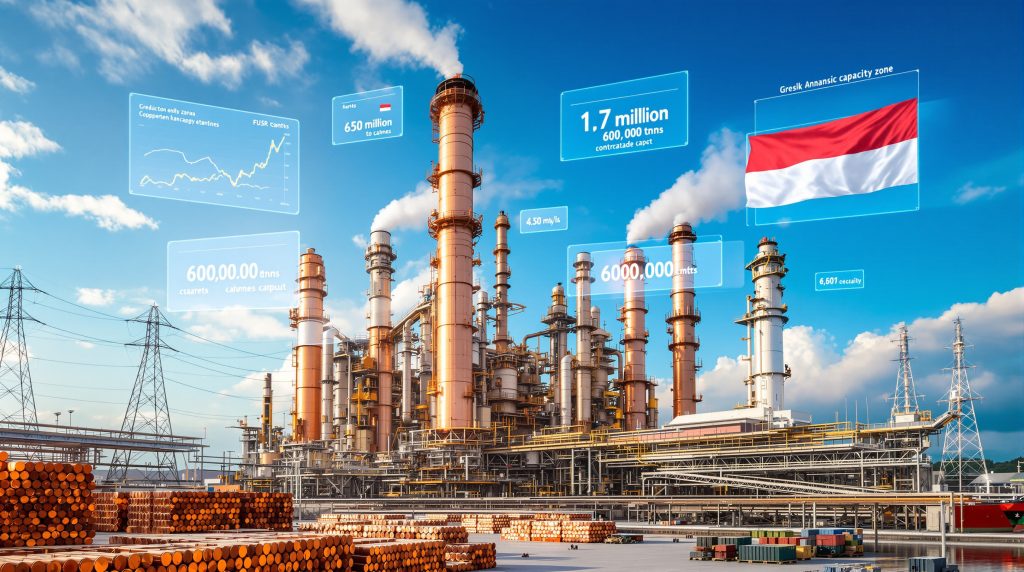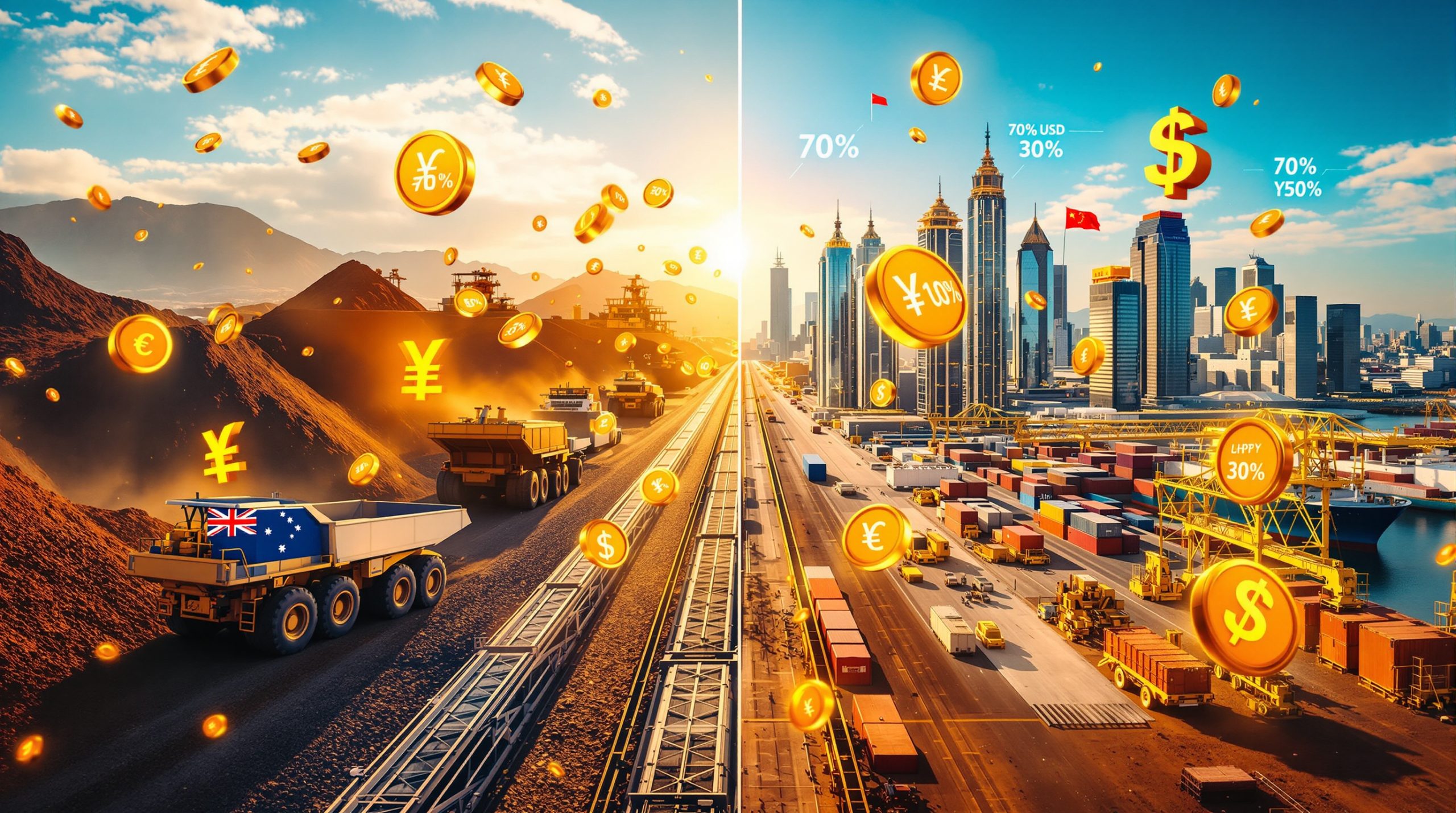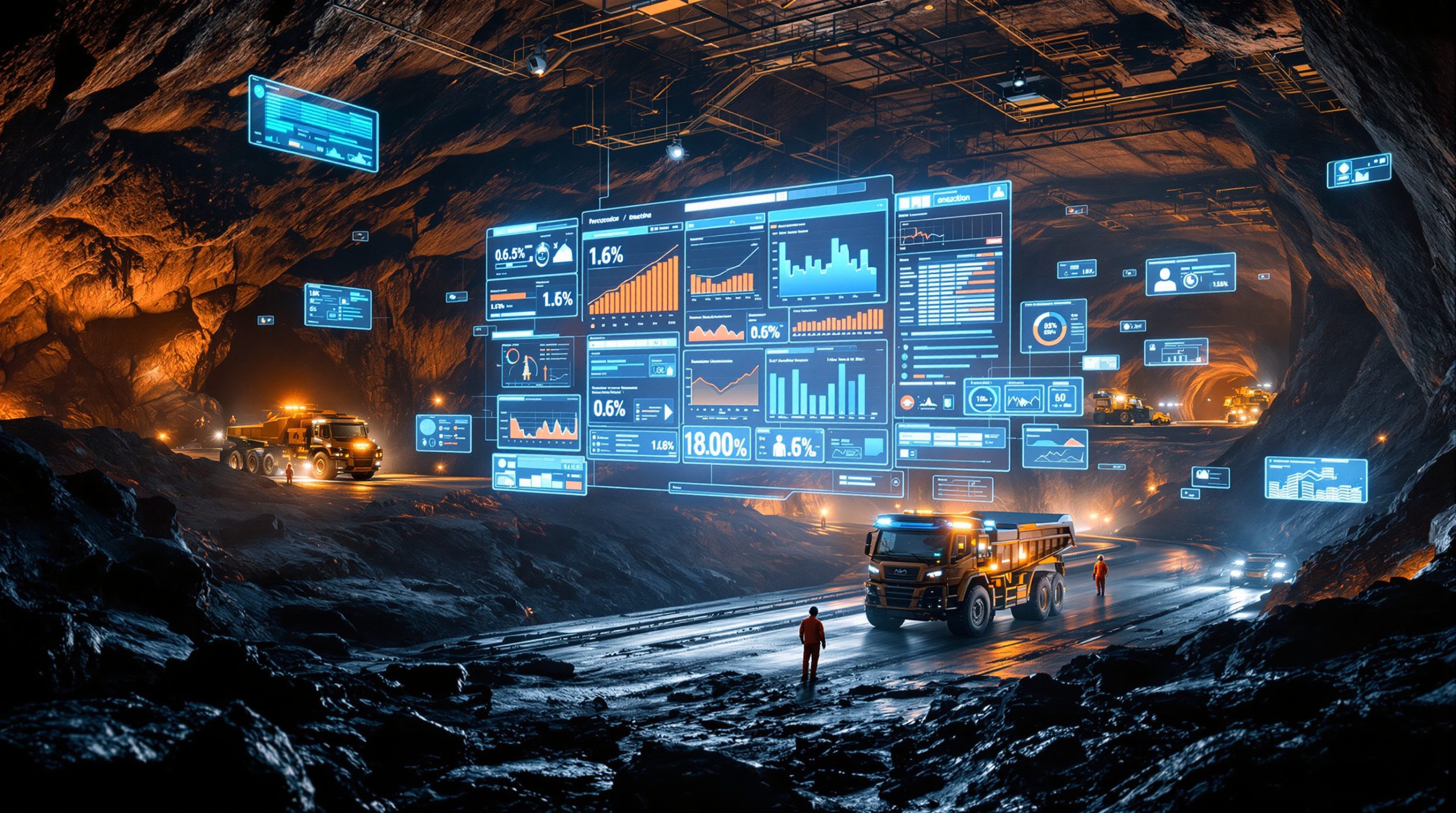The Manyar copper smelter project stands as a testament to Indonesia's ambitious downstream mineral processing strategy, representing a $3.7 billion investment that transforms the nation's position in global copper value chains. Furthermore, this massive metallurgical complex in East Java's Gresik industrial zone demonstrates how resource-rich countries can capture greater economic value through domestic processing rather than exporting raw concentrates.
The facility incorporates sophisticated pyrometallurgical systems that position Indonesia as a major player in global refined copper production. Beyond its primary smelting operations, the complex includes a $200 million precious metal refinery with capacity reaching 54 tonnes annually, demonstrating the project's comprehensive approach to mineral value extraction.
Strategic Location and Infrastructure Advantages
The Gresik location provides exceptional logistical advantages for large-scale metal processing operations. Consequently, the facility benefits from proximity to established port infrastructure capable of handling massive concentrate imports, while Java's electrical grid supplies the enormous power requirements of modern smelting technology.
Integration with existing refining infrastructure reduces operational complexity and capital requirements compared to greenfield developments. This strategic positioning allows the facility to leverage decades of metallurgical expertise while accessing skilled workforce populations in Indonesia's established industrial corridor.
Advanced Processing Capabilities
The Manyar copper smelter project incorporates multiple state-of-the-art processing technologies designed for maximum efficiency and environmental compliance. Moreover, the facility's design capacity positions it among the world's largest copper processing facilities, capable of handling concentrate volumes that significantly impact global supply chains.
| Processing Component | Annual Capacity | Technology Focus |
|---|---|---|
| Concentrate Processing | 1.7 million tonnes | Advanced smelting systems |
| Copper Cathode Production | 600,000 tonnes | Electrorefining technology |
| Precious Metal Recovery | 54 tonnes | Integrated refinery operations |
| Environmental Systems | Full compliance | Gas cleaning and acid recovery |
The precious metal refinery component represents a particularly sophisticated aspect of the operation, designed to extract gold, silver, and other valuable materials from copper concentrate processing. This integrated approach maximises revenue potential while ensuring comprehensive resource utilisation.
Why Did Indonesia Invest $3.7 Billion in Domestic Copper Processing?
Indonesia's downstream mineral strategy represents a fundamental transformation from traditional raw material export models. The massive investment in the Manyar copper smelter project reflects the government's determination to capture greater economic value from the nation's abundant mineral resources through domestic value-added processing.
This policy shift aims to reduce Indonesia's dependence on exporting unprocessed concentrates while building sophisticated industrial capabilities within the country. In addition, the surging copper demand in global markets supports this strategic approach to capture higher value-added processing revenues.
Economic Transformation Objectives
The project addresses multiple strategic objectives beyond simple mineral processing. Value addition through domestic smelting transforms raw concentrates worth hundreds of dollars per tonne into refined copper cathode commanding thousands of dollars per tonne in international markets.
Job creation extends throughout the supply chain, from direct smelter employment to supporting industries including logistics, maintenance, and technical services. The facility requires sophisticated technical expertise, creating opportunities for Indonesian engineers, metallurgists, and skilled technicians.
Technology transfer occurs through partnerships with international engineering firms and equipment suppliers. The project brings advanced metallurgical knowledge to Indonesia while building domestic capabilities for future expansion projects.
Export diversification reduces reliance on concentrate shipments while establishing Indonesia as a reliable refined copper supplier. This transformation potentially generates billions in additional export revenues compared to selling raw materials.
Resource Sovereignty Strategy
Indonesia's approach exemplifies growing resource nationalism trends where mineral-rich nations seek greater control over value chains. Rather than accepting traditional roles as raw material suppliers, countries like Indonesia increasingly demand downstream processing requirements for mining operations.
The Freeport Indonesia ownership structure reflects this strategy, with the Indonesian government holding majority control while maintaining operational expertise through international partnerships. This arrangement ensures Indonesian interests remain paramount while accessing world-class technical capabilities.
What Technical Challenges Have Emerged During Implementation?
Large-scale metallurgical projects face inherent complexity risks, and the Manyar facility encountered several significant operational hurdles that highlight the difficulties of commissioning advanced mine planning and processing systems. These challenges underscore the sophisticated nature of modern copper smelting technology.
Critical Operational Disruptions
The most significant setback occurred in October 2024 when a fire outbreak damaged essential plant components, forcing a complete operational shutdown. This incident demonstrated the vulnerability of complex metallurgical systems to equipment failures and the cascading effects of production interruptions.
"The seven-month shutdown from October 2024 through May 2025 highlighted the critical importance of comprehensive risk management and redundant systems in large-scale industrial operations."
The facility's restart in May 2025 represented a major milestone in overcoming technical challenges, though subsequent supply chain disruptions created additional operational pressures. These experiences provide valuable lessons for future mega-projects in the metals processing sector.
Supply Chain Vulnerability Factors
The Manyar smelter's dependence on concentrate supply from the Grasberg mine created operational vulnerabilities when mining incidents disrupted feedstock availability. A mud-flow disaster at Grasberg killed seven workers and halted mining operations for nearly a month, directly impacting smelter operations.
Industry analysts suggest Grasberg may not return to pre-accident operating rates until at least 2027, creating long-term supply challenges for the Manyar facility. This situation may force operational suspensions if alternative concentrate sources cannot be secured.
The interconnected nature of Indonesia's copper value chain means disruptions at mining operations directly translate to processing facility challenges. Furthermore, tariff impacts on copper supply add another layer of complexity to global sourcing strategies.
How Does This Impact Global Copper Supply Chains?
The Manyar smelter's operational status significantly influences international copper markets, particularly given Indonesia's position as a major concentrate producer through the massive Grasberg mining complex. The facility's capacity represents a substantial portion of global copper processing capability.
Market Dynamics and Supply Implications
When operational at full capacity, the Manyar facility processes 1.7 million tonnes of concentrate annually, removing substantial volumes from international concentrate markets while adding 600,000 tonnes of refined copper cathode to global supplies.
This transformation affects multiple market segments:
- Concentrate markets experience reduced Indonesian export volumes
- Refined copper markets gain significant new supply sources
- Smelting capacity utilisation shifts globally as processing moves to Indonesia
- Transportation patterns change from concentrate shipments to cathode exports
Strategic Resource Control Effects
Indonesia's processing strategy reduces global dependence on Chinese copper smelting capacity while creating alternative supply chains for international copper consumers. This diversification provides strategic value for manufacturers seeking supply security.
The facility's operational disruptions create ripple effects throughout global markets, influencing copper price prediction models, inventory management strategies, and alternative sourcing decisions. Extended shutdowns can trigger significant price volatility in international copper futures markets.
What Are the Environmental and Sustainability Features?
Modern copper smelting facilities must meet stringent environmental standards, and the Manyar project incorporates comprehensive pollution control and resource efficiency systems. These environmental technologies represent significant portions of total project investment while ensuring regulatory compliance.
Emission Control and Resource Recovery
The facility's environmental systems capture and process emissions while recovering valuable byproducts. Sulphuric acid production from sulphur dioxide capture creates additional revenue streams while minimising atmospheric releases.
Advanced gas cleaning systems ensure compliance with Indonesian environmental regulations while meeting international sustainability standards expected by global copper consumers. These systems represent critical infrastructure requiring continuous monitoring and maintenance.
Water management systems minimise freshwater consumption through closed-loop recycling, while slag processing creates construction materials from waste products. This comprehensive approach reduces environmental impact while maximising resource utilisation.
Regulatory Compliance Framework
The facility operates under Indonesia's evolving environmental framework, which increasingly emphasises pollution prevention and resource efficiency. Compliance requirements continue expanding as international pressure for sustainable mining practices intensifies.
International copper consumers increasingly demand environmental certifications and sustainability reporting from suppliers, making robust environmental systems essential for market access rather than simply regulatory compliance.
Who Are the Key Stakeholders and Operators?
The Manyar copper smelter project involves complex ownership structures reflecting Indonesia's resource sovereignty objectives while maintaining operational expertise from international mining companies. This partnership model balances Indonesian control with technical capabilities.
Ownership and Management Structure
Freeport Indonesia serves as the project owner, with the Indonesian government holding majority control while Freeport-McMoRan provides operational expertise. This arrangement ensures Indonesian strategic interests remain paramount while accessing world-class mining and metallurgical capabilities.
Chiyoda Corporation served as the primary engineering, procurement, and construction contractor, bringing Japanese industrial expertise to the project. This international partnership demonstrates the global nature of large-scale metallurgical project development.
The ownership model reflects broader trends in Indonesian resource development, where foreign expertise combines with domestic control to create nationally advantageous industrial projects. This approach allows Indonesia to build sophisticated capabilities while maintaining sovereignty over strategic resources.
Stakeholder Impact Distribution
Local communities benefit through employment opportunities and economic development, though specific job creation numbers remain undisclosed. The facility requires diverse skill sets from equipment operators to metallurgical engineers, creating opportunities across multiple education levels.
Global copper consumers represent critical stakeholders whose purchasing decisions determine project success. The facility must meet international quality standards while providing reliable supply relationships to justify massive capital investments.
Government stakeholders at multiple levels benefit from tax revenues, royalty payments, and strategic industrial development. The project demonstrates Indonesia's ability to execute sophisticated industrial projects while building technological capabilities.
What Does Full Production Capacity Mean for Indonesia?
Achieving design capacity represents a milestone in Indonesia's industrial development, demonstrating successful technology transfer and operational capability in advanced metallurgy. However, the facility's success validates Indonesia's downstream processing strategy while creating templates for future projects.
Economic Impact Projections
Full operations at 600,000 tonnes annual copper cathode production generates substantial export revenues at current copper prices. The facility's output represents a significant portion of Indonesia's total export value while creating multiplier effects throughout the regional economy.
| Economic Metric | Projected Impact | Development Significance |
|---|---|---|
| Annual Production | 600,000 tonnes cathode | Major global supply addition |
| Export Value | Multi-billion dollar revenue | Substantial foreign exchange earnings |
| Employment | Direct and indirect positions | Regional economic development |
| Tax Revenue | Government fiscal contribution | Infrastructure development funding |
The precious metal refinery component adds additional value through gold, silver, and platinum group metal recovery. These high-value materials significantly enhance project economics beyond base copper production.
Industrial Development Catalyst
The Manyar smelter's success demonstrates Indonesia's capability to execute world-class metallurgical projects, potentially attracting additional mineral processing investments. Success creates confidence among international partners while validating government industrial policies.
Technology transfer through the project builds Indonesian expertise in advanced metallurgy, creating human capital for future industrial development. Engineers, technicians, and managers gain experience applicable to other sophisticated manufacturing projects.
The facility establishes Indonesia as a credible participant in global refined copper markets, potentially leading to long-term supply contracts with major industrial consumers worldwide.
How Do Operational Delays Affect Market Dynamics?
Temporary shutdowns and ramp-up delays create significant ripple effects throughout global copper markets, influencing pricing mechanisms, inventory strategies, and supply chain management decisions. The Manyar facility's substantial capacity makes its operational status a market-moving factor.
Market Response Patterns
The seven-month shutdown from October 2024 through May 2025 removed substantial refined copper supply from global markets while potentially increasing concentrate availability. These supply shifts influence copper futures pricing and industrial purchasing strategies.
Price volatility increases when major production facilities experience unexpected disruptions. The Manyar facility's capacity represents sufficient market share to influence global copper pricing when operational status changes occur.
Inventory management strategies adjust when major suppliers face uncertainty. Industrial consumers increase safety stock levels while seeking alternative supply sources, creating demand pressure on other producers.
Investment decisions in other mining projects may accelerate when major facilities experience extended delays. Producers evaluate expansion opportunities when market tightness creates favourable pricing conditions.
Supply Chain Adaptation Mechanisms
Global copper consumers develop contingency planning when major facilities face operational challenges. Alternative sourcing arrangements become critical for maintaining production schedules in copper-intensive industries.
The facility's restart in May 2025 provided market relief, though subsequent supply chain challenges from Grasberg mine incidents created renewed uncertainty. These interconnected disruptions demonstrate the complexity of modern mineral supply chains.
Long-term supply contracts may include force majeure provisions addressing operational disruptions, while buyers diversify supplier relationships to reduce concentration risk from individual facilities.
What Lessons Emerge for Future Mega-Projects?
The Manyar experience provides valuable insights for other nations considering large-scale mineral processing investments, highlighting both opportunities and challenges in developing sophisticated metallurgical infrastructure. These lessons extend beyond copper processing to mining industry evolution generally.
Project Management and Risk Assessment
Technical complexity in advanced metallurgy requires extensive commissioning periods and comprehensive testing protocols. The Manyar facility's challenges demonstrate the importance of realistic timelines and contingency planning for complex industrial systems.
Supply chain integration represents a critical success factor, as the facility's dependence on Grasberg concentrate created operational vulnerabilities. Future projects should consider feedstock diversification strategies to reduce single-source dependencies.
Environmental systems require equal attention to production equipment, as emission control failures can halt operations regardless of smelting system functionality. Integrated environmental design prevents compliance-related shutdowns.
International partnerships balance technical expertise with domestic control objectives. The Freeport Indonesia model demonstrates how developing nations can access world-class capabilities while maintaining strategic asset control.
Policy and Regulatory Considerations
Balancing downstream processing objectives with operational realities requires flexible regulatory frameworks supporting long-term industrial development. Rigid export restrictions may create supply chain vulnerabilities during operational disruptions.
Government investment in technical education and training programmes enhances project success by providing skilled local workforce capabilities. Human capital development represents essential infrastructure for sophisticated industrial projects.
Environmental regulatory frameworks must evolve alongside industrial development to ensure sustainable operations while maintaining international competitiveness. Clear, consistent standards provide investment certainty for major projects.
What's Next for Indonesia's Copper Processing Strategy?
The Manyar facility represents the foundation of Indonesia's broader mineral processing ambitions, with potential expansion opportunities and additional projects under consideration. Success validates the downstream processing strategy while creating momentum for further industrial development.
Operational Optimisation and Expansion
Capacity optimisation focuses on achieving consistent full-scale operations while maintaining environmental compliance and safety standards. Stable operations provide the foundation for potential expansion considerations.
Technology upgrades may enhance processing efficiency and environmental performance over time. Continuous improvement programmes ensure the facility remains competitive with global processing standards.
Market expansion involves developing relationships with diverse copper consumers worldwide, reducing dependence on traditional Asian markets while accessing premium pricing opportunities.
Strategic Industry Development
Indonesia's success with the Manyar project may catalyse additional mineral processing investments throughout the archipelago. Other mining regions could develop integrated processing facilities following the Gresik model.
The facility demonstrates Indonesia's capability to execute world-class metallurgical projects, potentially attracting international investment in other mineral processing sectors. Nickel, aluminium, and steel processing could follow similar development patterns.
Near-term challenges include managing potential operational suspensions due to concentrate supply constraints from ongoing Grasberg mine recovery. Alternative feedstock sources may become necessary to maintain operational continuity.
Long-term prospects depend on successfully integrating the facility into global copper supply chains while building domestic metallurgical expertise for future expansion projects. The Manyar experience provides a template for Indonesia's continued industrial development in mineral processing sectors.
Disclaimer: This article contains forward-looking statements and projections based on current available information. Operational performance, market conditions, and regulatory requirements may differ from expectations. Readers should conduct independent research before making investment or business decisions related to copper markets or Indonesian industrial projects.
Ready to Capitalise on the Next Major Copper Discovery?
Discovery Alert's proprietary Discovery IQ model delivers instant notifications on significant ASX copper and mineral discoveries, transforming complex exploration data into actionable trading opportunities. Stay ahead of market-moving announcements like those that have historically generated exceptional returns by exploring Discovery Alert's discoveries page, then begin your 30-day free trial to secure your competitive advantage.




